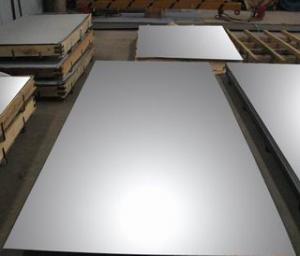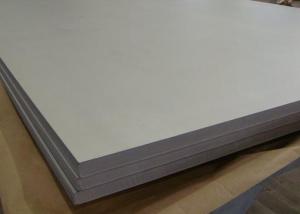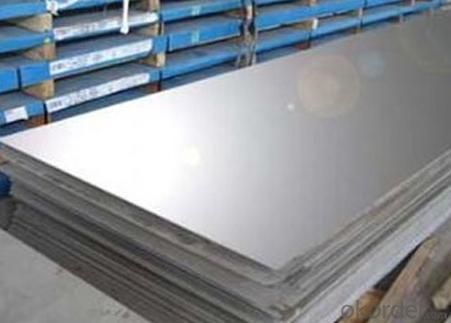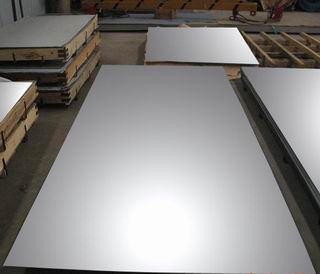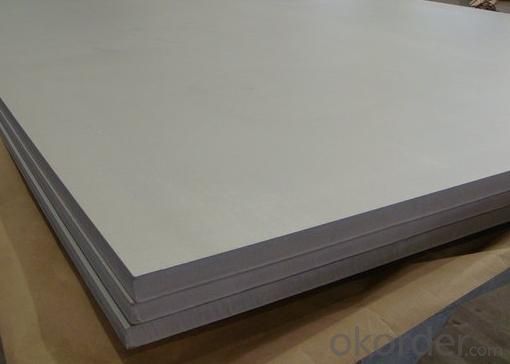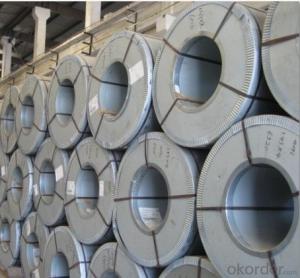Stainless Steel Plate
- Loading Port:
- China Main Port
- Payment Terms:
- TT or L/C
- Min Order Qty:
- 25MT m.t.
- Supply Capability:
- 3500MT Per Month m.t./month
OKorder Service Pledge
Quality Product, Order Online Tracking, Timely Delivery
OKorder Financial Service
Credit Rating, Credit Services, Credit Purchasing
You Might Also Like
- Q:Can stainless steel strips be formed into complex shapes?
- Complex shapes can indeed be formed from stainless steel strips. The versatility and ductility of stainless steel enable effortless shaping and manipulation. By employing techniques like bending, rolling, and stamping, intricate and complex forms can be achieved with these strips. Moreover, the remarkable strength and corrosion resistance of stainless steel make it perfect for applications demanding elaborate shapes, like architectural structures, automotive parts, and kitchen appliances.
- Q:How do stainless steel strips perform in acidic environments?
- In acidic environments, stainless steel strips possess a high resistance to corrosion, making them an ideal material for usage. The inclusion of chromium in stainless steel results in the creation of a protective layer, known as a passive film, on its surface. This passive film functions as a barrier, shielding the underlying steel from the damaging effects of the acid. Furthermore, stainless steel also contains other alloying elements like nickel and molybdenum, further bolstering its ability to withstand corrosion in acidic environments. As a result, stainless steel strips display remarkable durability and performance when exposed to acidic conditions, rendering them the preferred choice in a wide range of applications including chemical processing, food processing, and marine environments.
- Q:What is the electrical conductivity of stainless steel strips?
- The electrical conductivity of stainless steel strips may vary depending on the specific type and composition of stainless steel. In general, stainless steel is not as conductive as metals such as copper or aluminum. This is mainly due to stainless steel's higher resistance to the flow of electric current. However, there are stainless steel alloys that have been specially formulated to improve electrical conductivity. These alloys often contain higher amounts of elements like nickel or copper, which enhance the material's conductivity. It is important to consider that factors like temperature, surface condition, and strip thickness can also affect the electrical conductivity of stainless steel. Therefore, it is recommended to refer to specific data or consult with manufacturers to obtain accurate information regarding the electrical conductivity of stainless steel strips.
- Q:What is the density of stainless steel strips?
- The density of stainless steel strips can differ based on the precise grade and composition of the stainless steel utilized. Nonetheless, the average density of stainless steel strips is roughly 7.9 grams per cubic centimeter (g/cm³). This density is comparatively elevated in relation to alternative materials, rendering stainless steel strips an enduring and robust option suitable for diverse applications in industries including construction, automotive, and manufacturing.
- Q:Are stainless steel strips resistant to oxidation?
- Stainless steel strips exhibit resistance to oxidation due to their composition as an alloy containing chromium. When exposed to oxygen in the atmosphere, chromium reacts and creates a protective layer known as chromium oxide on the surface. This layer acts as a barrier, effectively halting any additional oxidation or corrosion of the metal. Consequently, stainless steel strips possess exceptional resistance to both rust and corrosion, rendering them highly suitable for applications involving moisture or challenging surroundings.
- Q:Are stainless steel strips suitable for heat treatment processes?
- Stainless steel strips are indeed suitable for heat treatment processes. Heat treatment is a widely employed technique for altering the physical and mechanical properties of metals, including stainless steel. By subjecting stainless steel strips to controlled heating and cooling cycles, it becomes possible to modify their hardness, strength, and other characteristics to meet particular requirements. To enhance machinability, formability, and resistance to corrosion, various heat treatment methods such as annealing, quenching, tempering, and precipitation hardening can be utilized on stainless steel strips. However, it is crucial to take into account the specific grade and composition of the stainless steel being utilized, as some grades may have limitations on the extent of heat treatment that can be applied. To ensure the appropriate heat treatment process is chosen for specific stainless steel strips, it is advisable to consult with a metallurgist or material specialist.
- Q:What are the advantages of using stainless steel strips?
- There are several advantages of using stainless steel strips in various applications. Firstly, stainless steel is known for its exceptional corrosion resistance. It can withstand exposure to moisture, chemicals, and other harsh environmental conditions without rusting or corroding. This makes it an ideal choice for applications that require long-lasting durability, such as in the construction industry or for outdoor equipment. Secondly, stainless steel strips offer excellent strength and stability. They have a high tensile strength, which means they can withstand heavy loads and pressure without deforming. This makes them suitable for applications that require structural integrity, such as in automotive manufacturing or in the production of machinery parts. Additionally, stainless steel is highly hygienic and easy to clean. It is non-porous, which means it does not trap dirt, bacteria, or other contaminants. This makes it a popular choice for applications in the food and beverage industry, medical equipment, and pharmaceutical manufacturing. Moreover, stainless steel strips have a high heat resistance, allowing them to withstand extreme temperatures without deforming or losing their strength. This makes them suitable for applications in high-temperature environments, such as in the aerospace industry or in the manufacturing of industrial furnaces. Furthermore, stainless steel is aesthetically pleasing and can be easily customized. It has a sleek and modern appearance, making it a popular choice in architecture and interior design. It can also be easily shaped, welded, and polished, allowing for various design possibilities. Lastly, stainless steel is a sustainable and environmentally friendly material. It is 100% recyclable, which reduces the need for new raw materials and minimizes waste. Additionally, stainless steel does not release harmful substances or toxins during its production, making it safe for both human health and the environment. Overall, the advantages of using stainless steel strips include corrosion resistance, strength, hygiene, heat resistance, customization options, and sustainability. These qualities make stainless steel a versatile and reliable material for a wide range of applications in various industries.
- Q:How do stainless steel strips perform in the presence of sulfuric acid?
- Under certain conditions, sulfuric acid generally does not corrode stainless steel strips. The performance of stainless steel when exposed to sulfuric acid is influenced by various factors, including the acid's concentration and temperature, the grade of stainless steel, and the duration of exposure. At room temperature, stainless steel is typically resistant to weak sulfuric acid solutions (up to 10%). The natural passive film on the stainless steel surface provides excellent corrosion protection under these circumstances. The specific grade of stainless steel can affect its resistance, with austenitic stainless steel (e.g., 304 and 316) offering better corrosion resistance compared to ferritic or martensitic grades. However, as the concentration or temperature of sulfuric acid increases, the corrosion resistance of stainless steel may diminish. Higher concentrations (above 10%) or elevated temperatures can lead to localized corrosion, such as pitting or crevice corrosion. To combat this, higher alloyed stainless steels, like duplex or super duplex grades, are commonly employed as they offer improved resistance to sulfuric acid. It is crucial to note that prolonged exposure to sulfuric acid can eventually cause corrosion in stainless steel. To minimize the risk, it is advisable to limit the exposure time and acid concentration. Regular maintenance and proper cleaning practices can also help preserve the corrosion resistance of stainless steel in the presence of sulfuric acid.
- Q:What are the common flatness tolerances for stainless steel strips?
- The common flatness tolerances for stainless steel strips vary depending on the specific grade and thickness of the material. However, in general, the industry standard flatness tolerances for stainless steel strips are typically specified as a maximum deviation from a perfectly flat surface. For precision or high-quality stainless steel strips, the common flatness tolerance is often expressed in terms of "bow" or "camber" measurements. Bow refers to the deviation of the strip from a straight line while camber refers to the deviation from a flat surface. The typical flatness tolerance for bow or camber in stainless steel strips can range from 0.5mm to 2mm per meter of length. On the other hand, for standard or commercial-grade stainless steel strips, the flatness tolerances may be slightly higher. It can range from 1mm to 4mm per meter of length. It is important to note that these tolerances are just general guidelines and can vary depending on the specific requirements of a project or application. Additionally, manufacturers and suppliers may have their own specific flatness tolerances based on their capabilities and equipment. It is always recommended to consult the manufacturer or supplier for the exact flatness tolerances for a particular stainless steel strip.
- Q:What industries commonly use stainless steel strips?
- Stainless steel strips are widely used in various industries due to their exceptional properties and versatility. One industry that commonly utilizes stainless steel strips is the automotive industry. These strips are used for manufacturing various automotive components such as exhaust systems, trim, and decorative elements due to their corrosion resistance, strength, and aesthetic appeal. Another industry that extensively uses stainless steel strips is the construction industry. These strips are employed in the construction of infrastructure, such as bridges, tunnels, and buildings, as they offer excellent structural integrity, durability, and resistance to environmental factors. Stainless steel strips are also utilized for roofing, siding, and cladding applications. The food processing and packaging industry also rely heavily on stainless steel strips. These strips are preferred for their hygienic properties, as they are easy to clean, resistant to bacterial growth, and non-reactive to food products. Stainless steel strips are used in the production of equipment like conveyors, mixers, and food storage containers. Furthermore, the medical and pharmaceutical industries heavily rely on stainless steel strips for their equipment and instruments. Stainless steel's biocompatibility, corrosion resistance, and ease of sterilization make it ideal for surgical tools, dental instruments, medical implants, and pharmaceutical manufacturing equipment. Other industries that commonly use stainless steel strips include the aerospace industry, where they are used for aircraft components, and the energy industry, where they are utilized in power plants, oil and gas processing, and renewable energy systems. Overall, the diverse range of properties offered by stainless steel strips makes them a popular choice across various industries, providing durability, corrosion resistance, hygiene, and strength, among other benefits.
1. Manufacturer Overview |
|
|---|---|
| Location | Hebei,China |
| Year Established | 1989 |
| Annual Output Value | Above US$160 Thousand |
| Main Markets | Europe, East Asia and Southeast Asia |
| Company Certifications | ISO9001:2000; |
2. Manufacturer Certificates |
|
|---|---|
| a) Certification Name | |
| Range | |
| Reference | |
| Validity Period | |
3. Manufacturer Capability |
|
|---|---|
| a)Trade Capacity | |
| Nearest Port | Tianjin |
| Export Percentage | 70% |
| No.of Employees in Trade Department | 30 People |
| Language Spoken: | English;Chinese |
| b)Factory Information | |
| Factory Size: | Above 14,500 square meters |
| No. of Production Lines | Above 6 |
| Contract Manufacturing | OEM Service Offered;Design Service Offered |
| Product Price Range | Average |
Send your message to us
Stainless Steel Plate
- Loading Port:
- China Main Port
- Payment Terms:
- TT or L/C
- Min Order Qty:
- 25MT m.t.
- Supply Capability:
- 3500MT Per Month m.t./month
OKorder Service Pledge
Quality Product, Order Online Tracking, Timely Delivery
OKorder Financial Service
Credit Rating, Credit Services, Credit Purchasing
Similar products
New products
Hot products
Hot Searches
Related keywords
